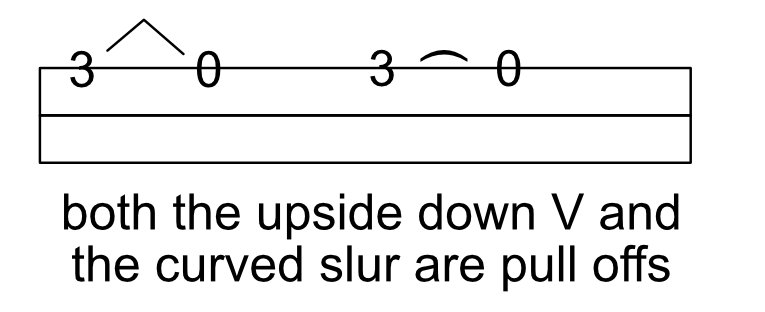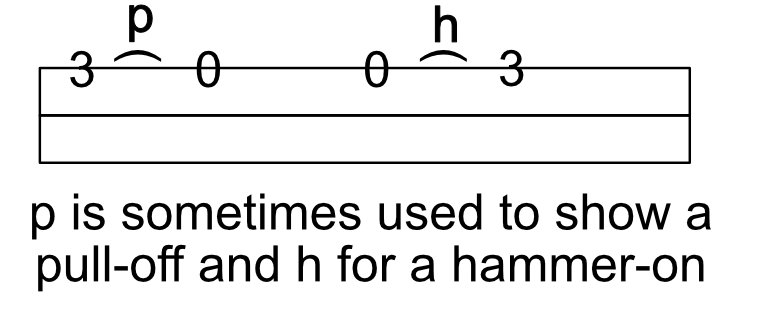A pull off is played by playing a fretted note and then lifting off the fretting finger to leave either an open note or a lower fretted note. If you need a lower fretted note, place both fingers on the correct fret before playing the 1st note. In notation the pull off is shown with a slur sign:

What Are The 2 Main Types Of Pull-Off On A Cigar Box Guitar?
Pull-offs can be played from a fretted note to the open string or from a fretted note to a lower fretted note. Plucking the string and then lifting the higher fretting finger off allows the lower note to sound without plucking the string again.
How Do I Play A Pull-Off To An Open String?
Place your fretting finger on the string, pluck it with your other hand using a finger or plectrum and then remove the fretting finger.
If the fretting finger is lifted straight up the pull-off is quieter than if the fretting finger moves slightly to the side so if you’re struggling to get any volume try this :
I like to push down a bit and then kind of bounce my finger off in a positive action. I tend to move my fretting finger slightly to the side but not enough to bend the note. It’s a bit like I’m plucking the string ever so slightly with my fretting hand. This gives me a little bit more volume.
Playing with my cigar box guitar plucked into an amp definitely helps to get more volume with a pull-off.
If I’m using a slide I can still play a pull-off even though slides are more often used to slide down ( or up) to the note required.
How Do I Play A Pull-Off When I Need To Fret Both Notes?
This is slightly more tricky as you have to fret both frets on the same string with 2 different fingers before you pluck the string. This means that depending on how far you can stretch some pull-offs are impossible to play. e.g in the example above I cannot stretch to hold the 10th and 3rd fret on the same string so it is impossible for me to play that pull-off.
- position both fretting fingers on the same string
- pluck the string once
- push down slightly before you lift off the finger to increase the volume
- the lower fretted note should ring out
Improving The Sound Of Guitar Pull-Offs
In addition to the tip above about increasing the volume, a good exercise to help with this is to perform a pull-off followed by a hammer- on followed by another pull off etc. The pull off is the opposite of a hammer-on. If you want to find out about hammer-ons read my article coming soon.
You need to develop the muscle memory and strength in your fretting fingers to play good sounding pull-offs ( and hammer-ons).
If you need to fret both notes, here are some additional tips:
- Firstly practice your fretting positions and play the note twice, once on the higher fret and then once on the lower. This lets you check that the lower fret is being pressed down with the right pressure and in the correct position.
- Try to position both fretting fingers just behind the fret wire as this gives a good sound that is in tune and not muted any way.
- When you are confident that the sound is good try just plucking the string the first time, lifting the higher finger just as you did when playing the pull-off to the open note.
- It’s not a good idea to play the note twice too many times or your muscle memory will make it hard for you to remember that you are playing a pull-off and not 2 separate notes.
- You don’t need to press too hard- if you find that pressing both frets down is taking the string out of pitch as you are bending the string, try slightly less pressure.
When you are learning any new technique it’s easy to get discouraged with the progress you are making, especially when you compare yourself to other players so :
- DON’T rush- this technique takes time to learn
- DO practice slowly and steadily
- DO read about hammer-ons in my article and practice pull-offs and hammer-ons together.
- DO keep practicing until you can perform a trill ( repeated hammer-ons and pull-offs)
- DO have fun- this is a way of you personalizing your music and adding little tweaks to improve your playing
When Should I Use Guitar Pull-Offs?
Guitar pull-offs are used in many different styles of music from blues to country to rock and metal. They allow for much quicker notes to be played as the string is only plucked once for 2 notes.
If you are watching someone play, it’s really hard to see if they are using pull-offs because you need to see both hands at once. However your ears should help once you know the distinctive sound. They add interest to the music just like hammer-ons, slides and bends do.
Repeated hammer-ons and pull-offs give a trill which is a rapid repeating of 2 notes on the same string. You wouldn’t be able to pluck a string that fast.
They are a little tricky to get the hang of, especially ones that require fretting 2 notes at once, but once you get the hang of it you can try using them in riffs that you are already familiar with to add a bit of variety.
How Is A Pull-Off Shown In Guitar Tab Or Music?
Sometimes in tab music the slur sign is replaced with a V shape pointing up like this:

The letter p is sometimes shown to distinguish a pull off from a hammer on which sometimes has an h. But if there is no letter remember that hammer-ons go up to higher note and pull-offs come down to a lower one:

Other Techniques To Look At To Improve Your Cigar Box Guitar Repertoire
I Have written an article about hammer-ons which you can read : How To Hammer-On With A Cigar Box Guitar which also contains information about slides and bending notes. These are all intermediate techniques or at least advanced beginners but will add a lot of interest to your playing.
